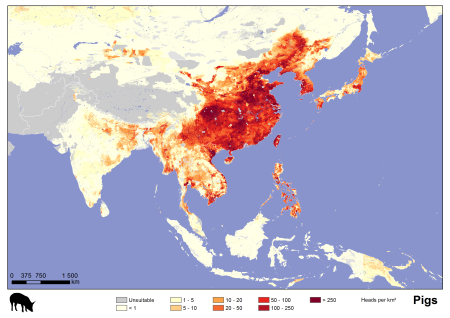- There are some really old breweries out there.
- And some really old grape seeds in Sardinia.
- The beauty of hops. New and old.
- Some very photogenic old sheep breeds in the Lake District.
- Someone has discovered some old salt-tolerant rice landraces. Also medicinal and aromatic rices. Well I never.
- Meanwhile, at the other end of the rainbow, the Chinese dip a toe into gourmet GM rice.
- Brit boffins breed flood-proof barley.
- Botanical gin. Two of my favourite things, combined.
- Saving the Pau Brasil is, well, complicated. But what else was it going to be?
- Yet another roundup of the pros and cons of quinoa.
Livestock mapping comes of age
For your information, we have been beavering away since then, collecting more recent and detailed sub-national livestock statistics and disaggregating these using a slightly modified modelling approach, and 1 km multi-temporal, Fourier-processed MODIS imagery from the University of Oxford. We hope in time to produce global coverage for the most important livestock species, and make these publically available, but we have focussed our initial efforts on poultry and pigs in Asia.
![]() That was Timothy Robinson in a comment on a post of ours back in 2012, and he’s been true to his word. There was a paper last year 1, and there’s a wiki for the data.
That was Timothy Robinson in a comment on a post of ours back in 2012, and he’s been true to his word. There was a paper last year 1, and there’s a wiki for the data.

I suggested in my earlier post that it was possible to get the impression that a lot of different players were working in parallel, if not in actual competition, on livestock distribution mapping. If that was indeed the case, and perhaps it was just an impression, it all seems to have been resolved in the intervening couple of years, thank goodness. According to the wiki:
In a multi-partner collaboration centered on the International Livestock Research Institute (ILRI), the Food and Agriculture Organization of the United Nations (FAO) and the Université Libre de Bruxelles (ULB-LUBIES), global maps of livestock distributions and production systems are being revised and updated.
Only fair to add that I landed on this via a blogpost on Vox, of all places, which has been getting quite a lot of attention on Twitter, for some reason. It seems to have escaped my early warning system last year.
Nibbles: Biltong, Coco de mer, PGRFA course, Poplar genebank, IRRI genebank, African agriculture, Hybrid chickens, American food
- Professor wants to copyright the name biltong, should be forced to eat nothing else until he takes it back.
- Getting to the bottom of coco de mer.
- PGRFA course at Wageningen. Expensive, but worth it, and you can apply for a NFP/MENA Fellowship, check on the course overview PDF.
- The IRRI genebank manager has seen the future of genebanks: “…we need to work on building the system to estimate breeding value from genotype, and then we will be able to feed more detailed knowledge to the breeders.” He probably means DivSeek. Now IRRI really need to get a different stock image of him and his genebank.
- The UK now has a National Black Poplar Clone Bank. Not quite as big as the above.
- A different take on Bill’s Big Bet. And more along the same lines.
- Hybrid Kuroiler chickens a big hit in Uganda. Bill may be onto something after all.
- “As American as apple pie” is just the beginning. I want to see Kuroilers at KFC.
Nibbles: Conservation course history, Language and DNA, Entomophagy blog, IPBES help, Phenomics methods database, Sustainable Nestlé, Got other milk?, NCYC
- University of Birmingham conservation course alumnus/a? This one’s for you.
- Phonemes follow human genomes. Kinda. No word on crop and livestock genomes. Yet.
- A whole blog on eating insects.
- Interesting: “Each IPBES assessment must include reference citations to indigenous knowledge, and every review panel must include experts in this.”
- Curated list of methods in Plant Phenotyping and Phenomics.
- Nestlé’s sustainable agriculture guy visits CIAT, plants coconut, talks supply chains.
- Camelcino, anyone?
- UK yeast genebank reaches totally arbitrary milestone.
Nibbles: Taro recipes, Pawpaw Kickstarter, Pica, Slow seeds, Forest foods, Pork rises, Landscapes, Best friend, Cooking & CC
- Ok, now you have no excuse not to eat taro.
- Do your bit to help pawpaws (Asimina triloba) go viral. No, wait, that didn’t come out right.
- “Pica is an unexplainable food curiosity—the overwhelming desire to eat the inedible.” Or, as we say in my house, German food.
- Tuscan seed journey.
- Living off forest foods can be fun.
- Pork beats beef.
- Picturing the Earth. Some of it ain’t pretty. But even then it’s pretty.
- Picturing working dogs. All of them pretty.
- Kenyan chef Ali L’artiste tucks into Rwandan bananas and beans before it’s too late.